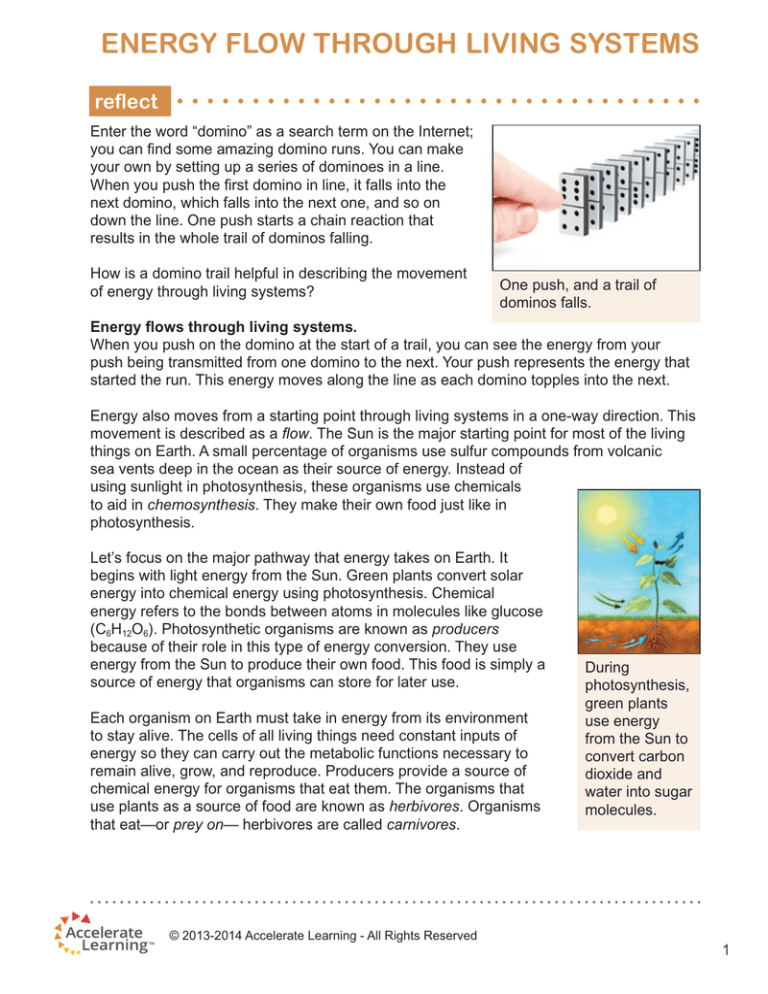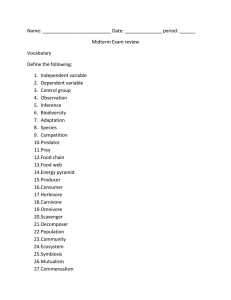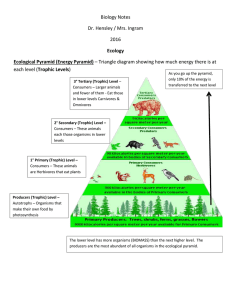
ENERGY FLOW THROUGH LIVING SYSTEMS
reflect
Enter the word “domino” as a search term on the Internet;
you can find some amazing domino runs. You can make
your own by setting up a series of dominoes in a line.
When you push the first domino in line, it falls into the
next domino, which falls into the next one, and so on
down the line. One push starts a chain reaction that
results in the whole trail of dominos falling.
How is a domino trail helpful in describing the movement
of energy through living systems?
One push, and a trail of
dominos falls.
Energy flows through living systems.
When you push on the domino at the start of a trail, you can see the energy from your
push being transmitted from one domino to the next. Your push represents the energy that
started the run. This energy moves along the line as each domino topples into the next.
Energy also moves from a starting point through living systems in a one-way direction. This
movement is described as a flow. The Sun is the major starting point for most of the living
things on Earth. A small percentage of organisms use sulfur compounds from volcanic
sea vents deep in the ocean as their source of energy. Instead of
using sunlight in photosynthesis, these organisms use chemicals
to aid in chemosynthesis. They make their own food just like in
photosynthesis.
Let’s focus on the major pathway that energy takes on Earth. It
begins with light energy from the Sun. Green plants convert solar
energy into chemical energy using photosynthesis. Chemical
energy refers to the bonds between atoms in molecules like glucose
(C6H12O6). Photosynthetic organisms are known as producers
because of their role in this type of energy conversion. They use
energy from the Sun to produce their own food. This food is simply a
source of energy that organisms can store for later use.
Each organism on Earth must take in energy from its environment
to stay alive. The cells of all living things need constant inputs of
energy so they can carry out the metabolic functions necessary to
remain alive, grow, and reproduce. Producers provide a source of
chemical energy for organisms that eat them. The organisms that
use plants as a source of food are known as herbivores. Organisms
that eat—or prey on— herbivores are called carnivores.
During
photosynthesis,
green plants
use energy
from the Sun to
convert carbon
dioxide and
water into sugar
molecules.
© 2013-2014 Accelerate Learning - All Rights Reserved
1
ENERGY FLOW THROUGH LIVING SYSTEMS
The diagram below shows the overall flow of energy through living things. At each step,
the transfer of energy involves a loss of energy in the form of heat and body activities. For
example, when you exercise you get hot. The heat you feel in your body results from the
energy transfers that happen when you move. When you sweat, your body expends energy
to cool itself down.
look out!
Energy may be lost in living systems as it flows through them. However, this energy is not
lost completely from the universe. All energy within the universe can be accounted for at
any time. This is because the total amount of energy in the universe is constant. Energy is
never created and never destroyed. Energy is only converted from one form into another.
As energy moves between living things, some energy—in the form of heat—is lost. This
thermal energy escapes into the environment and is no longer useful to organisms, but it is
not destroyed.
A food chain shows how energy flows from one organism to another.
In general, energy flows from the Sun to producers and then to consumers. The path is
linear as the energy present in one step is transferred to the next. You can find specific
examples of this pathway in an ecosystem.
For example, suppose you observed a grassland ecosystem. There, you would see
grass and scattered trees growing in a field. The grass and trees are producers that use
sunlight to carry out photosynthesis. Grasshoppers are herbivores that live in grassland
ecosystems. They get energy by eating grass and leaves.
© 2013-2014 Accelerate Learning - All Rights Reserved
2
ENERGY FLOW THROUGH LIVING SYSTEMS
Another transfer of energy occurs when a frog preys on a grasshopper. Later, another
energy transfer occurs when a snake captures and eats the frog. We can represent the
path of energy flow in this scenario using the following flowchart:
A food chain is a specific path of energy transfer within an ecosystem. In this
food chain, energy flows from the Sun to grass to a grasshopper to a frog to a
snake. What organism could be the next step in this food chain?
A food web represents the interconnected food chains within an ecosystem.
There are many food chains in any given ecosystem. Any one organism often plays a
role in several food chains. All of the food chains, with their many interconnections in an
ecosystem, make up a food web. A portion of the food web for the grassland ecosystem
discussed above could be diagrammed as follows:
The arrows in a food web indicate the direction of energy transfer. Within one food web are
many food chains. For example, you can see in the food web shown on previous page that the
mouse is part of three food chains. It eats plants and is eaten by cougars, owls, and snakes.
© 2013-2014 Accelerate Learning - All Rights Reserved
3
ENERGY FLOW THROUGH LIVING SYSTEMS
An energy pyramid shows the distribution of energy within an ecosystem.
So far we have looked at ecosystems with an emphasis on the direction of energy flow.
So far we have looked at ecosystems while emphasizing the direction the energy flow, but
what do we know about the amount of energy within an ecosystem? How is the amount of
energy distributed?
In order to answer these questions, we need to classify and define specific energy levels
within an ecosystem. These levels are called trophic levels. Producers represent the first
trophic level. Producers are sometimes also referred to as primary producers. Herbivores,
or primary consumers, represent the second trophic level. Primary consumers feed
on producers. Carnivores, or secondary consumers, represent the third trophic level.
Secondary consumers feed on primary consumers. Tertiary consumers and quaternary
consumers make up the last two trophic levels. (Tertiary means “third level,” and quaternary
means “fourth level.”) Tertiary consumers feed on secondary consumers. Likewise,
quaternary consumers feed on tertiary consumers. (Tertiary and quaternary consumers are
also carnivores.)
Earlier, we briefly talked about how the amount of energy changes as it is transferred from
one organism to the next. Recall that some energy is given off to the environment as heat
during transfers. Because some energy is lost as heat during and between energy transfers,
the amount of energy retained in living organisms decreases as you move up through
each trophic level. In other words, less energy is available for consumers at each level of
the energy pyramid. Specifically, only about 10% of the total energy at one trophic level is
passed on to the next higher trophic level. For example, if 1000 kilocalories of energy are
present at the primary producer level, one-tenth of this energy, (about 100 kilocalories)
is passed to the primary consumers in the next level. Even less energy is available for
secondary, tertiary, and quaternary consumers.
The diagram on the next page uses box sizes to represent the amount of energy present at
each trophic level. The largest box at the bottom contains the primary producers. The next
largest box contains the primary consumers. Secondary consumers are next, followed by
tertiary consumers. At the top is the smallest box, representing the quaternary consumers.
Altogether the stacked boxes make up a pyramid called an energy pyramid. An energy
pyramid represents both the distribution of energy and the direction of energy flow within an
ecosystem.
© 2013-2014 Accelerate Learning - All Rights Reserved
4
ENERGY FLOW THROUGH LIVING SYSTEMS
This energy pyramid contains several terms you may not
recognize. Primary producers are also called autotrophs. The
prefix auto- means “self.” (An autobiography is a book you write
about yourself.) The root troph comes from a Greek word meaning
“nourishment.” So, an autotroph is something that nourishes,
or feeds, itself by producing its own food. All consumers are
heterotrophs. The prefix hetero- means “other.” So a heterotroph is
something that feeds itself by eating other things.
look out!
Decomposers, such as mushrooms and bacteria, are consumers because they break
down the bodies of dead organisms. This recycles matter for future organisms to use.
Decomposers do not occupy a specific trophic level of an energy pyramid. Instead, they
extract energy from dead organisms throughout the pyramid.
© 2013-2014 Accelerate Learning - All Rights Reserved
5
ENERGY FLOW THROUGH LIVING SYSTEMS
what do you think?
Biomass is the mass of matter in living things. Like the quantity of energy in an ecosystem,
the quantity of biomass in an ecosystem can be represented as a pyramid. How do you
think the specific trophic levels are organized within the biomass pyramid? Do you think
biomass increases or decreases as you go from producers to consumers? To help you
answer these questions, try to sketch a biomass pyramid.
Everyday Life: Where are humans located in an energy pyramid?
Think about the foods you eat. If you are like most people, you eat a variety of foods. These
include fruits and vegetables, which came from producers. You may also eat beef, chicken,
and fish, which are consumers. People who eat both meat and plant-based foods are
omnivores. People who eat only plant-based foods call themselves vegetarians, and are
classified as herbivores.
Omnivores move back and forth between several different trophic levels because of
the variety of foods they eat. This makes omnivores primary, secondary, tertiary, and
quaternary consumers. People who have vegetarian diets occupy only the lowest consumer
trophic level because they eat only producers. Vegetarians are only primary consumers.
What do you know?
The following images (A, B, and C) show three different organisms. Place each organism
in the correct place in the energy pyramid on the next page. Use an arrow to indicate how
energy would flow between these organisms. Use additional arrows to indicate where
energy might be removed from living organisms as heat.
Image A: Deer
Image B: Wolves
Image C: Tree
© 2013-2014 Accelerate Learning - All Rights Reserved
6
ENERGY FLOW THROUGH LIVING SYSTEMS
Energy Pyramid:
connecting with your child
Food Webs and Energy Pyramids in Marine Ecosystems
This companion focuses on terrestrial ecosystems, that is, ecosystems on land. To help students
learn more about food webs and energy pyramids, have them carry out research in the library
or on the Internet to find examples of food webs in marine ecosystems, that is, ecosystems in
water, including oceans, lakes, rivers, ponds, and wetlands. Have your child use the information
he or she collects to draw a detailed food web showing specific marine organisms and their
relationships to one another. Your child will then take this information, construct an energy
pyramid, and label the trophic levels with the names of the organisms that occupy them.
Here are some questions to discuss with your child:
• What organisms carry out photosynthesis in this marine ecosystem?
• What organisms would be considered primary consumers in this marine ecosystem?
• What organisms are secondary consumers?
• What organisms are at the tops of the food chains in this marine ecosystem?
© 2013-2014 Accelerate Learning - All Rights Reserved
7








